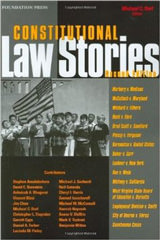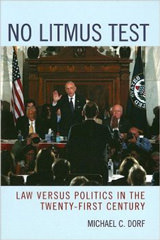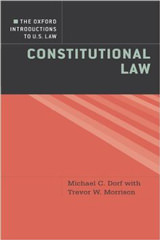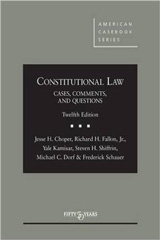When President George H.W. Bush nominated David H. Souter to the U.S. Supreme Court, his Chief of Staff John Sununu boasted that the nominee was a “home run” for the conservative legal movement. Sununu based that assessment on the recommendation of his fellow New Hampshire native, Republican Senator Warren Rudman. But Rudman himself had no real basis for such a judgment. Based on Souter’s service as New Hampshire Attorney General and his brief service as a federal appeals court judge, it was evident that he had smarts, wisdom, and integrity, but Souter was never a movement conservative. Once on the Supreme Court, on key questions like abortion, church-state separation, gun control, LGBTQ rights, and states’ rights, Souter reliably voted with the liberals.
Souter’s perceived apostasy made movement conservatives apoplectic, in no small part because Souter was hardly the first appointee of a Republican president whose independence of mind ended up frustrating their ideological agenda. Among the appointees of Presidents Nixon, Ford, Reagan, and the first Bush, we can count the following Justices who were either moderates or liberals, at least with respect to several key issues: Harry Blackmun; Lewis Powell; John Paul Stevens; Sandra Day O’Connor; Anthony Kennedy; and finally, David Souter. After Souter joined four other Republican appointees to reaffirm the constitutional right to abortion (in a 1992 decision that would remain on the books for another three decades)—activists in the conservative legal movement vowed: “no more Souters.”
In the years since, Republican presidents have been largely successful in appointing Justices who are ideologically reliable. To be sure, even generally quite conservative Justices occasionally disappoint the most partisan Republicans—as when Chief Justice John Roberts (appointed by President George W. Bush) cast a decisive fifth vote to uphold Obamacare in 2012, or when Justice Neil Gorsuch (appointed by President Donald Trump) wrote the lead opinion (joined by the Democratic appointees and Chief Justice Roberts) construing the federal workplace civil rights law to forbid discrimination based on sexual orientation or transgender status in 2020.
However, those cases and others like them are one-offs. Broadly speaking, Republican appointees since Souter have been much less likely than their predecessors in prior decades to drift to the center or left of the Court. Justice Clarence Thomas—whom the first President Bush appointed the year after he appointed Justice Souter—can be understood to have spoken for three decades’ worth of ensuing Republican appointees when he quipped to his law clerks early in his tenure: “I ain’t evolving.”
But here’s the thing: Justice Souter—who died last week—was a traditional conservative Justice. In vowing “no more Souters” and seeking Justices in the mold of Justice Thomas and Justice Samuel Alito, movement conservatives have done more or less exactly what they have been accusing liberals of doing since the Warren Court of the 1950s and 1960s: subordinating methodological and jurisprudential commitments to ideological ones.
A Successor to Justice Felix Frankfurter and the Second Justice Harlan
During the early Warren Court, Justice Felix Frankfurter was often in dissent on key cases involving civil rights and civil liberties. Frankfurter was, in his personal views, liberal. Indeed, he co-founded the ACLU. However, unlike some of the other Justices who were veterans of the New Deal—especially Hugo Black and William O. Douglas—Frankfurter adopted judicial restraint as his methodological watchword. From the late nineteenth century into President Franklin D. Roosevelt’s second term, a conservative activist Court repeatedly struck down progressive legislation in the name of the Constitution. Frankfurter concluded from that period that courts ought generally to defer to political actors.
Generally did not mean always, however. Frankfurter joined the unanimous decision in Brown v. Board of Education and some other civil rights and civil liberties cases. But he refused to go along with Justices Black and Douglas, who argued that the Fourteenth Amendment incorporates against—that is to say, makes applicable to—the states, the specific provisions of the Bill of Rights, which limits only the federal government. Frankfurter thought that Black’s formalism fetishized the happenstance of constitutional text. In Frankfurter’s view, the Bill of Rights is a hodgepodge of rights: some are universal in the sense that they belong in any liberal democratic constitution, while others reflect the particular concerns of the founding generation of Americans. Whether an asserted right should be found within the Fourteenth Amendment’s Due Process Clause, Frankfurter thought, should not depend on whether there happened to be a parallel mention of it in the Bill of Rights.
Justice John Marshall Harlan (the grandson of a Justice with the same name) joined the Court in 1955, serving initially as Frankfurter’s ally and then his successor. Harlan’s arguably most important opinion was his 1961 dissent from the Court’s jurisdictional dismissal in Poe v. Ullman, which pre-figured the majority holding, but not the rationale, of Griswold v. Connecticut four years later. Justice Douglas, speaking for the majority in Griswold, sought to locate a right of married couples to use contraceptives in the “penumbras” and “emanations” of the specific provisions of the Bill of Rights—a jurisprudential move that has been mocked ever since.
Harlan’s rationale was much more straightforward. He thought the provisions of the Bill of Rights were useful in identifying our nation’s core values, but unlike Douglas or Black (who dissented in Griswold), he did not think that invocation of the rights enumerated by the Bill of Rights made the exercise of judgment unnecessary. Harlan wrote:
Due process has not been reduced to any formula; its content cannot be determined by reference to any code. The best that can be said is that, through the course of this Court’s decisions, it has represented the balance which our Nation, built upon postulates of respect for the liberty of the individual, has struck between that liberty and the demands of organized society. If the supplying of content to this constitutional concept has of necessity been a rational process, it certainly has not been one where judges have felt free to roam where unguided speculation might take them. The balance of which I speak is the balance struck by this country, having regard to what history teaches are the traditions from which it developed as well as the traditions from which it broke. That tradition is a living thing. A decision of this Court which radically departs from it could not long survive, while a decision which builds on what has survived is likely to be sound. No formula could serve as a substitute, in this area, for judgment and restraint.
Souter Channeled Frankfurter and Harlan Contra Scalia and Alito
That passage provokes three observations. First, in it, Justice Harlan staked out a position contrary to the formalism of Black and Douglas, as well as the formalism of their successor, Justice Antonin Scalia. Notably, Scalia repeatedly stated that he objected to substantive due process—the practice of locating substantive constitutional rights in the due process clause—except that he accepted incorporation of the Bill of Rights. Scalia, like Black and Douglas, fetishized text, and did so in exactly the same way that Black did when it came to substantive due process.
Second, in his Poe dissent, Harlan rejected not only the formalism of Black (and anticipatorily, the formalism of Scalia as well). Harlan also rejected the narrow view of history as a guide to constitutional interpretation that the Roberts Court has lately endorsed—most dramatically in Justice Alito’s overruling of the right to abortion in Dobbs v. Jackson Women’s Health Org. in 2022. Harlan insisted on attentiveness to the traditions from which our country broke, not just to the traditions we once observed.
Third, throughout his Supreme Court tenure, Justice Souter applied the Harlan methodology. Perhaps the best exemplar is his 1998 opinion for the Court in County of Sacramento v. Lewis. All nine Justices agreed that the parents and the estate of a motorcyclist who died as a result of a high-speed police chase could not successfully sue for a constitutional violation, but, in addition to Justice Souter’s majority opinion, there were five separate concurring opinions. Despite agreeing on the outcome, Justice Souter clashed with Justices Scalia and Thomas over methodology.
Justice Souter’s opinion set out to determine whether the plaintiff had suffered a constitutional wrong by asking whether the police conduct “shocked the conscience,” a test drawn explicitly from Justice Frankfurter’s 1952 majority opinion in Rochin v. California. He answered that question using a form of analysis that evoked Justice Harlan in Poe. “Rules of due process are not,” he wrote, “subject to mechanical application in unfamiliar territory. Deliberate indifference that shocks in one environment may not be so patently egregious in another.” Elsewhere in the opinion, Justice Souter described a “spectrum” of culpability, echoing Harlan’s “continuum” of rights.
In his concurrence in the judgment, Justice Scalia, joined by Justice Thomas, complained that Justice Souter’s methodology was too subjective. He also thought it inconsistent with the methodology of a case from the prior term, Washington v. Glucksberg. Nearly a quarter of a century later, Justice Alito would cite the methodology of the Glucksberg case in Dobbs as authority for overruling the abortion right.
The battle between Souter, on one hand, and Scalia and Thomas, on the other, played out in numerous other cases as well. One can also hear Justice Souter restating the argument after his retirement during his magnificent 2010 speech at the Harvard commencement. I recommend the full speech to readers, but even a brief excerpt reveals Souter’s basic judicial philosophy as an extension of the Frankfurter/Harlan approach. He said:
The Constitution is a pantheon of values, and a lot of hard cases are hard because the Constitution gives no simple rule of decision for the cases in which one of the values is truly at odds with another. Not even its most uncompromising and unconditional language can resolve every potential tension of one provision with another, tension the Constitution’s Framers left to be resolved another day; and another day after that, for our cases can give no answers that fit all conflicts, and no resolutions immune to rethinking when the significance of old facts may have changed in the changing world.
Readers whose working knowledge of the Supreme Court goes back only a few decades may see in that passage a version of living Constitutionalism they associate with liberalism, and they are not entirely wrong. Justice Souter was Whitman-esque, containing multitudes. But the larger part of his judicial philosophy traces most clearly to Frankfurter and Harlan. It is best described as small-c conservative.
When Republican politicians vow “no more Souters,” they are opposing, not espousing conservatism. And they are rejecting the very best of their tradition. We need more Souters—desperately.











